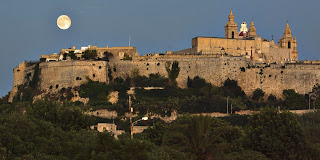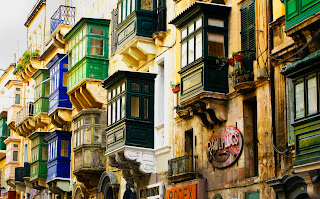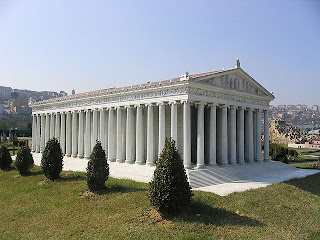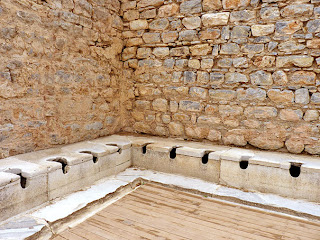 |
| MUST-SEA: Valletta Grand Harbour, the most photographed view on Malta. Is it any wonder? |
FOR an intelligent man, Saint Paul was an awful eejit. If only he’d stayed put in Malta, where he was shipwrecked in 60AD during a voyage to Rome, he might have been buried in one piece. But no. This first century Robinson Crusoe converted the islanders to Christianity — they were putty in his hands after he laughed off a bite from a venomous snake — then continued his journey. Big mistake. The Emperor Nero being no pal of Paul, he ordered the executioner to get his axe and look sharpish, and that’s why in 67AD the poor old Apostle turned up at the Pearly Gates with his head under his arm. If he’d turned up at the Ryanair gate they’d probably have made him check it in.
I wouldn’t mind being shipwrecked on Malta, especially in July and August when the average mid-afternoon temperature is 30C/86F and often hits 35/95, though a welcome sea breeze takes the sting out of it. It’s a popular destination in winter too when it’s usually T-shirt weather (around 15/59) and sunny all day — except last Monday, when I got a soaking in the capital, Valletta, and boarded the plane home that evening with the beginnings of a stinking cold. Fortunately, I’d had three runny nose-free days to enjoy the Christmas weekend there.
 |
| DIRECT HIT: Bombed Church of the Assumption in Mosta |
 |
| NAZI SURPRISE: Replica bomb |
High on the list of attractions not to be sneezed at is the Church of the Assumption of Our Lady in Mosta. This splendid structure, which has the third-biggest dome in Europe after Saint Peter’s Basilica in Rome and the Hagia Sophia in Istanbul, is well worth a look, but it’s the story of the 1942 “Miracle of Mosta” that has visitors flocking to the place year-round. In the late afternoon of April 9, while 300 parishioners gathered for mass during a German air raid (they felt safe enough within the church’s nine-metre thick walls), a 200-kilo bomb came crashing through the dome. While the congregation rapidly blessed themselves for what they thought was the last time, they watched in horror as the bomb bounced and clattered down the aisle towards the altar — and failed to explode. Good thing too, as there was a fireworks factory next door.
Hitler’s Luftwaffe and Mussolini’s Regia Aeronautica blitzed the bejaysus out of Malta during World War Two — there was only one 24-hour period in the 175 days between January 1 and July 24, 1942, when no bombs fell on Valletta and the island’s other ports and air bases. The Siege of Malta, from early June 1940 until late November 1942, aimed to bomb or starve the strategically-important yet woefully under-defended island into submission. It was the heaviest and most concentrated and sustained aerial bombardment in history, during which 30,000 buildings were damaged or destroyed and the 250,000 islanders were forced to kill and eat all the horses because food was so desperately short.
Salvation came nearer in the months leading up to the Allies’ victory at the second Battle of El Alamein in November 1942 when the Axis commanders began diverting much of their attention away from Malta to northern Egypt, allowing the RAF in stages to station 250 Spitfires on the island. Faced with increasing opposition (21-year-old Canadian Spitfire pilot George ‘Screwball’ Beurling shot down 27 Axis aircraft over Malta in just 14 days), the Germans and Italians eventually scarpered with their tailfins between their legs. When a supply convoy of four merchant ships from Alexandria reached Valletta on November 20 virtually unscathed, the siege was over and the long-suffering islanders were able to emerge from the deep underground tunnels where they’d been forced to shelter for nearly two-and-a-half years from round-the-clock air raids.
 |
| BLITZED: Destruction in Valletta's Kingsway street |
 |
| JUST REWARD: The George Cross awarded to island |
Their courage had been recognised the previous April when King George VI awarded Malta one of only two collective George Crosses ever conferred (the other went to the Royal Ulster Constabulary in 1999). In a letter to the island’s Governor, Lieutenant-General Sir William Dobbie, the King wrote: “To honour her brave people, I award the George Cross to the Island Fortress of Malta to bear witness to a heroism and devotion that will long be famous in history.” Dobbie replied: “By God’s help Malta will not weaken but will endure until victory is won.” The medal, which is depicted on the Maltese flag, and the King’s letter can be seen in the War Museum in Valletta’s Fort Saint Elmo.
Nearby, the island’s top visitor attraction, The Malta Experience, has hourly showings of a fascinating 40-minute film that highlights significant events from 7,000 years of history, including the Great Siege of 1565 when 30,000 Turks failed to overwhelm 6,000 defenders.
Driving in the smallest member of the European Union (it’s just 27km by 15) can be overwhelming, and requires a degree of heroism worthy of mention in dispatches. Locals joke that the slimmest book in the library is the Maltese Highway Code, which had me chuckling until my pal Paula took me out for a spin. It was no tongue-in-cheek statement — my heart was in my mouth more often than in my chest as we were tailgated by insanely impatient motorists, cut across, overtaken on blind bends and wrong-footed by cars indicating left then turning right. In Sliema, on the peninsula across Grand Harbour from Valletta, I watched another example of motoring madness as a young woman directing her husband into a parking space was almost run over by an old fella in a battered Morris Marina who nipped in and claimed it. I don’t know what she said to him during a two-minute tirade in Maltese, but it drew a sharp intake of breath from my neighbours on a cafe terrace and he quickly reversed out and sped off.
| JUST THE TICKET: One of Malta's redundant vintage buses |
If your nerves are easily jangled, it’s better to hop on a bus — the quaint old yellow and orange ones that feature in countless holiday snaps were replaced in July by a modern fleet — but even then there’s no guarantee of a smooth ride. I’ve seen train-spotters and plane-spotters, but until I boarded the number 52 from Valletta to Dingli for a look at the nearby cliffs I’d never encountered bus-spotters, and I never want to again. For nearly 40 minutes I stood on that crowded bus having to listen to the biggest load of old drivel from a dozen camera-toting public transport fanatics from Lancashire as they excitedly discussed the new vehicles (especially the bend-in-the-middle ones), the new timetable and the new routes. I wouldn’t have minded, but I’d forgotten to recharge my iPod and the battery was drained. And then, just as I was thinking it couldn’t get any worse, a well-meaning teenage girl who recognises pain on the face of a fellow passenger when she sees it added insult to injury by getting up and insisting I take her seat.
The 51, 52 and 53 buses are among the busiest out of Valletta as they stop at Rabat, home of the magnificent medieval walled city of Mdina, a World Heritage Site also known as the Silent City that sits on a rocky promontory and was the Maltese capital centuries before Valletta was even thought of. Mdina’s warren of narrow, cobbled streets that suddenly open on to picturesque, flower-bedecked squares full of noblemen’s townhouses and palaces are dotted with cafes and shops selling tasteful souvenirs (nothing so tacky as mass-produced mementoes here), with the biggest sellers being colourful Mdina glass, amber jewellery and lace. The imposing Cathedral of Saint Paul, built between 1697 and 1702 on the site of a previous church destroyed by an earthquake in 1693, is impressive from a distance and even more so when viewed up close, but the best view in Mdina — a sweeping vista of central Malta to the sea — is from Bastion Square.
 |
| LUNAR LANDSCAPE: The medieval former capital, Mdina |
Valletta, also a World Heritage Site, isn’t short of bastions, many of which are a dizzying 47 metres tall. The city’s foundation stone was laid on March 28, 1566, by Jean Parisot de la Valette, the Grand Master of the Order of Saint John of Jerusalem which later became the Sovereign Military Hospitaller Order of Saint John of Jerusalem of Rhodes and of Malta but is better known as the more easily remembered Knights of Malta. The city was planned as a refuge for injured soldiers and pilgrims during the Crusades and built over the course of just 15 years, including tea breaks, on a uniform grid system that has been copied countless times worldwide.
As in most historical cities awash with magnificent, centuries-old buildings, it pays to look up every now and then when wandering through Valletta to avoid missing something worth seeing, such as the brightly-painted and well-kept balconies. It also pays to look down. Go to the Upper Barrakka Gardens, lean on the railing and feast your eyes on the most-photographed and famous sight in Malta, the Grand Harbour and the Three Cities of Cospicua, Vittoriosa and Senglea which you can visit by jumping aboard a water taxi.
Back at street level, step inside the Pro Cathedral and gaze at Caravaggio’s huge and gruesome painting, The Beheading of Saint John the Baptist (1608). Photos aren’t allowed in the room that houses this masterpiece, but that’s OK because the image will stay with you and possibly give you nightmares, especially if you’ve over-indulged in gbejna goat and sheep’s milk cheese, a delicacy from the smaller neighbouring island of Gozo that’s absolutely delicious. I brought some back last week and am rationing myself to a slice a day to make it last as long as possible.
 |
| QUALITY STREET: Balconies of houses in Valletta |
Sliema — home to umpteen designer boutiques and art galleries and the hub of Maltese cafe life where all the rich kids with fancy cars hang out — and Saint Julian’s are the main tourist resorts around the capital, which is a favourite port of call for cruise liners. In both places you’ll find some of the best restaurants on the island, especially the trendy and brilliant value Italian I Monelli in Saint Julian’s, where the bill for dinner for five with loads of wine and beer came to an unbelievable €123. A short stroll away is The Dubliner pub, a favourite with expats and visitors because a) it’s a genuine Irish boozer, not one of those prefabricated, self-assembly joints that blight holiday hot spots throughout the Mediterranean, and b) the staff are Irish.
In Sliema, Ta’ Kris Restaurant and Bistro serves the most wonderful Maltese cuisine including roast and stewed rabbit, veal escalopes and the national dish, bragioli (savoury stuffed beef rolls braised in wine). It’s always busy, packed with people swearing they’ll never set foot in the place again because the service is so terrible. It isn’t terrible at all: the waitresses are super-efficient and charming, but often there just aren’t enough of them. I had lunch there on Christmas Eve when every table was taken, but only two girls were on duty to seat customers, take orders, pour drinks, serve food, work the cash register and clean up. After waiting 40 minutes for our starters, my five Maltese friends began grumbling (so did my stomach). Half-an-hour then passed before the main courses arrived. One of our group was daft enough to ask for dessert — a slice of cheesecake — and got it 20 minutes later. It took another 20 minutes between asking for and receiving the bill, but at the end of our meal all five left generous tips and were making arrangements to have lunch there the following week. That’s how good the food is.
Despite all the heavy sighing and tut-tutting from diners, the waitresses remained calm and focused. Like their fellow islanders before them they were under siege, but refused to buckle. Those two girls deserve medals.
| SPLASH OUT: Book into the Phoenicia Hotel, Valletta |
WHERE TO STAY
The Irish-owned 5-star Phoenicia Hotel in Valletta is handily located next to the bus station, and most of the 128 rooms and eight suites have views of the Grand Harbour. Opened in 1947, it has welcomed royalty, film stars, honeymooning couples and families and remains a favourite with regular visitors to Malta. See www.phoeniciamalta.com for details of special deals.
GETTING THERE
For flights from Dublin to Malta, see www.ryanair.com and www.airmalta.com. Easyjet (www.easyjet.com) flies from Belfast. In Ireland, Concorde Travel are Malta specialists. See
www.concordetravel.ie/
www.concordetravel.ie/
˜For further information, see www.visitmalta.com
























